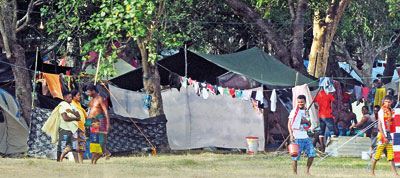Madhu: Journey of devotion
 When Prasad Anthony came on the Madhu pilgrimage last year, he prayed for two things to happen and made a vow to come back if his wishes were granted. A few months later he went abroad and on his return, he was able to build a small house for his young family. Having achieved his wishes, this year he came to the Shrine of our Lady of Madhu happy to fulfil the vow at the church festival held on July 2.
When Prasad Anthony came on the Madhu pilgrimage last year, he prayed for two things to happen and made a vow to come back if his wishes were granted. A few months later he went abroad and on his return, he was able to build a small house for his young family. Having achieved his wishes, this year he came to the Shrine of our Lady of Madhu happy to fulfil the vow at the church festival held on July 2.“I was able to go abroad to work as a fisherman and build my house. That’s what I wished for last year,” Anthony explained with a smile.
Anthony is one of around 400,000 devotees who flocked to the Madhu shrine, this year. Considered the country’s holiest Catholic shrine, it dates back to the latter part of the 17th century. The statue of Our Lady of Good Counsel, was moved from Mantai in Jaffna to Madhu, for protection from the Dutch. The church was built in 1872, along with a grotto and presbytery for priests.
For many Catholics, it is an annual pilgrimage. Anthony travelled from Negombo, with 10 others, among them his father Joseph Regis, who was on his 33rd pilgrimage to the Our Lady of Madhu Shrine.

“I used to cycle all the way here from Negombo,” recalls Regis, a fisherman by trade like his son. “We would start our journey around 11p.m. and reach the Shrine around five in the evening the following day.”
That was before the ethnic unrest began, Regis explained. With the war breaking out, the annual pilgrimage became a hazardous journey. But the family never missed a single festival except once, at the height of the war, Regis says very proudly.
The family requests for accommodation through the Bishop’s office in Colombo. Their request for a room along with other similar requests is decided through a lottery system. The family sometimes gets a room for their accommodation during the festival, and if they don’t, they camp out in the church grounds along with many others.
Similarly many pilgrims from the Northern Province flock to Madhu shrine for the festival. Gnanaraj Croos and his family too make this annual pilgrimage to the shrine. Their group comes to the shrine a month before the July 2 feast.
“We work hard all year as fishermen to come here on the pilgrimage, stay here with the entire family and go back,” explains Croos.
The Croos family too depends on fishing for a living, and they take 20 days off their trade to come to Madhu Shrine. Now the pilgrimage is a lot easier than before, thanks to good access roads and peaceful conditions, Methalin Croos says.
“Earlier when we set off the journey we had to wait hours at the check points,” she recalled.
“It would take over two hours to check one bus of pilgrims, and we would sometimes have to wait on the roadside for almost a day at a time.”
The families bring their own camping gear to the site to set up makeshift tents with sheets and sarees. All the families camping in the grounds both from the south and north of the island cook and eat together during the festival time.
Once the church feast is over, they leave with warm goodbyes and promises to return the next year to Madhu that has a special place in their hearts.




